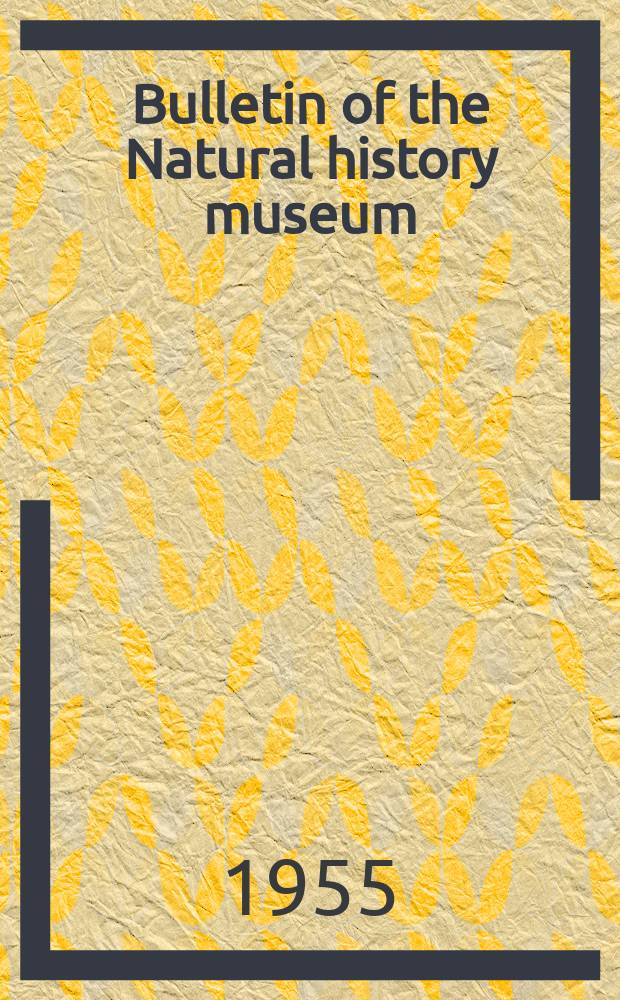Science Bulletins: Shrinking Glaciers—A Chronology of Climate Change
Analysis of Earth's geologic record can reveal how the climate has changed over time. Scientists in New Zealand are examining samples from the rocky ...
American Museum of Natural History
The Attenborough - Fortey talk What's in a name? | Natural History Museum
Join Sir David Attenborough and Richard Fortey.
Natural History Museum
Science Bulletins: When Young Brains Become Social
A brain imaging study from MIT and Yale researchers reveals the neural regions underlying social cognition—the ability to recognize other people's thoughts ...
American Museum of Natural History
Science Bulletins: Underwater Microscope Zooms in on Tiny Marine Life
Most plankton are too small to be seen with the naked eye. But despite their size, they are vital in marine and freshwater ecosystems, serving as food for larger ...
American Museum of Natural History
Science Bulletins: Super- Star of the Universe
A local star is the most massive ever detected.
American Museum of Natural History
Force Thirteen US Onsite at the Natural Science Museum
Our US Director took a day to take in the Natural History and Natural Science Museum in Raleigh NC it was here he found a Collage of Hurricane Related Facts ...
Force Thirteen XTRA
Science Bulletins: Decoding the DNA of Extinct Species
Caves were important refuges for humans and animals that coexisted during the late Pleistocene, the epoch of ice ages that ended 10000 years ago.
American Museum of Natural History
Science Bulletins: Making Fossils Hear
When did human beings first develop the ability to speak? This remains one of the most exciting and perplexing questions for researchers of human evolution ...
American Museum of Natural History
Science Bulletins: How Did Saturn Get Its Rings?
Astronomers propose a new theory to explain Saturn's unusual rings.
American Museum of Natural History
Anthony Kampf's Research
In these videos, Drs. Kampf and Gaillou discuss their research projects on behalf of the museum. View the full article at ...
Official GIA Channel
When Carnivores Took to the Water
AMNH scientist Camille Grohé studies the evolutionary history of aquatic carnivores, including otters, seals and sea lions. How and when did their land-dwelling ...
American Museum of Natural History
Wood Framed SwingFrame Bulletin Boards with Customizable Message Headers
With DisplayFrames.com New Online Frame and Display Customizer you can create the perfect wood framed SwingFrame Designer Bulletin Board with your ...
DisplayFrames
Duchess of Cambridge visits Natural History Museum | 5 News
Subscribe to 5 News: http://bit.ly/5NewsSub ▻ The Duchess of Cambridge was taken on a journey of discovery, handling a meteorite and peering at common ...
5 News
Science Bulletins: Stem Cells Made from Eggs Alone
Stem cells are cells that can develop into virtually any type of body tissue. Evenutally, it may be possible to use stem cells to create healthy tissues to replace ...
American Museum of Natural History
Selection of Books in Box 87
Selections and descriptions of books for sale from EdAugustsBooks.com 19 books Scythian Art: Khai Khosru Monographs of Eastern Art. General Editor: Arthur ...
Ed Augusts Books
Science Bulletins: Gene Patterns Point to Long Lives
To better understand the biology of healthy aging, the Boston University School of Medicine is studying a unique population of Americans—centenarians, ...
American Museum of Natural History
Major fire breaks out at natural history museum in Delhi | Manorama News
Major fire breaks out at natural history museum in Delhi | The official YouTube channel for Manorama News. Manorama News, Kerala's No. 1 news and ...
Manorama News
Science Bulletins: Supernova of a Lifetime
A recent stellar explosion in a nearby galaxy gave astronomers a rare glimpse into the early stages of a supernova. Supernova PTF 11kly is only 21 million ...
American Museum of Natural History
Science Bulletins: "Body Clock" Found in Bone
Many body processes operate in rhythms, often called "biological clocks." A team of researchers led by Timothy Bromage at the New York University College of ...
American Museum of Natural History
Nature's Fury: Tsunami Science - Reducing the Risk
The scientific data left in the wake of the horrific December 26, 2004 tsunami is proving invaluable to better prepare for future events. Learn more at Nature's ...
American Museum of Natural History
REAL: El REGISTRO FÓSIL demuestra la EVOLUCIÓN
En pleno siglo XXI todavía hay quienes eligen creer que la evolución es falsa a pesar de las múltiples evidencias que la apoyan. Hay quien dice que el registro ...
El Pakozoico
Dinosaurs of Copper Ridge - Part 2/2
This video is part 2 in a 2 part series about reconstructing the dinosaurs that left their tracks at Copper Ridge, near Moab Utah. In this part I discuss ...
BRIAN ENGH PALEOART
Science Bulletins: Ancient "Kitchen" Reveals Modern Hunting Skills
How early humans hunted and ate their food can be a gauge of cognitive ability. It takes more strategic planning to capture large, healthy, adult game, transport it ...
American Museum of Natural History
Science Bulletins: Signs of Speech Ability Seen in Neanderthals
Could Neanderthals speak? Researchers from the Max Planck Institute for Evolutionary Anthropology in Germany—the same team that sequenced large ...
American Museum of Natural History
Science Bulletins: Neanderthal Genome Sheds Light on Humanity
Neanderthals were our closest relatives. These stocky, heavy-browed humans lived from about 200000 to 30000 years ago in Eurasia and the Middle East.
American Museum of Natural History
Science Bulletins: Early Human Walked Upright
Since a few 6-million-year-old bones of the species Orrorin tugenesis were discovered in Kenya in 2000, scientists have not been certain that Orrorin could walk ...
American Museum of Natural History
Science Bulletins: Skull fills Gap in Fossil Record
Some periods of human prehistory lack a substantial fossil record in key geographic locations, making it difficult to confirm genetic evidence of modern human ...
American Museum of Natural History
Nature's Fury: Monitoring Mount Etna - Magma on the Move
Visit the volcano Etna's snowy slopes and learn how scientists from the Italian National Institute for Geophysics and Volcanology use data collection to predict ...
American Museum of Natural History
Science Bulletins: Chimps Show Complex Body Language
Apes use complex combinations of gestures and facial and vocal signals to communicate. A new study by scientists at the Yerkes National Primate Research ...
American Museum of Natural History
Great Debate (astronomy) - Video Learning - WizScience.com
In astronomy, the "Great Debate", also called the "Shapley–Curtis Debate", was an influential debate between the astronomers Harlow Shapley and Heber ...
Wiz Science™
Science Bulletins: In Search of Wild Variety
To help build the catalog of life, biologists at AMNH search the globe for species that have never been scientifically described. Discover seven of these new ...
American Museum of Natural History
Science Bulletins: Genes in the Urban Environment
Much of who we are biologically is determined by an interplay between our genes and the environment we live in. To learn how the transition of human ...
American Museum of Natural History
The Most Embarrassing Archaeological Blunders
Check my other channel Geographics: https://www.youtube.com/channel/UCHKRfxkMTqiiv4pF99qGKIw →Subscribe for new videos every day!
TopTenz
Science Bulletins:Tuberculosis's Hidden Strategy
Tuberculosis can linger for years, but usually carries no symptoms. Scientists from the International Center for Genetic Engineering and Biotechnology in India ...
American Museum of Natural History
Science Bulletins: Did Climate Change Guide Early Migrations?
An international team of scientists has completed analysis of sediment cores pulled from several African lakes, providing the first long, continuous record of ...
American Museum of Natural History
Science Bulletins: Genes and Geography—They Go Together
Scientists can now analyze a person's genes to pinpoint what country his or her ancestors hailed from. A team of U.S. researchers recently performed a massive ...
American Museum of Natural History
Science Bulletins: Ancient Graves Reveal Family Ties
In 2005, a team of archaeologists unearthed a well-preserved group of 4600-year-old graves in the agricultural region of Eulau, Germany. People were buried ...
American Museum of Natural History
Science Bulletins: Ancient Immunity May Have Upped HIV Risk
Retroviruses insert their genetic material into an organism's DNA to replicate. Over time, the viral DNA can inactivate and remain as a "fossil" relic the DNA ...
American Museum of Natural History
Science Bulletins: Have Humans Adapted to the Western Diet?
Italian scientists report that people in Western countries lack the diversity of stomach bacteria found in rural villagers in Africa. The implication is that our bodies ...
American Museum of Natural History
Crocodile tracks - Virtual Museum
more info at http://pfalkingham.wordpress.com Presented here are digital models of [the casts of] tracks from 12 species of extant crocodile. The physical data ...
Peter Falkingham
La momie du Far West (Edmontosaurus).
Histoire de la première découverte d'un fossile de dinosaure recouvert de sa peau fossilisée. De l'histoire de Charles Sternberg & fils jusqu'aux découvertes ...
Graine de savoirs
Science Bulletins: Making Faces for Survival
Ask any person, from any country‚ to make a fearful face and you'll get the same response-eyebrows raised, eyes wide open, flared nostrils. A disgusted face, on ...
American Museum of Natural History


























































